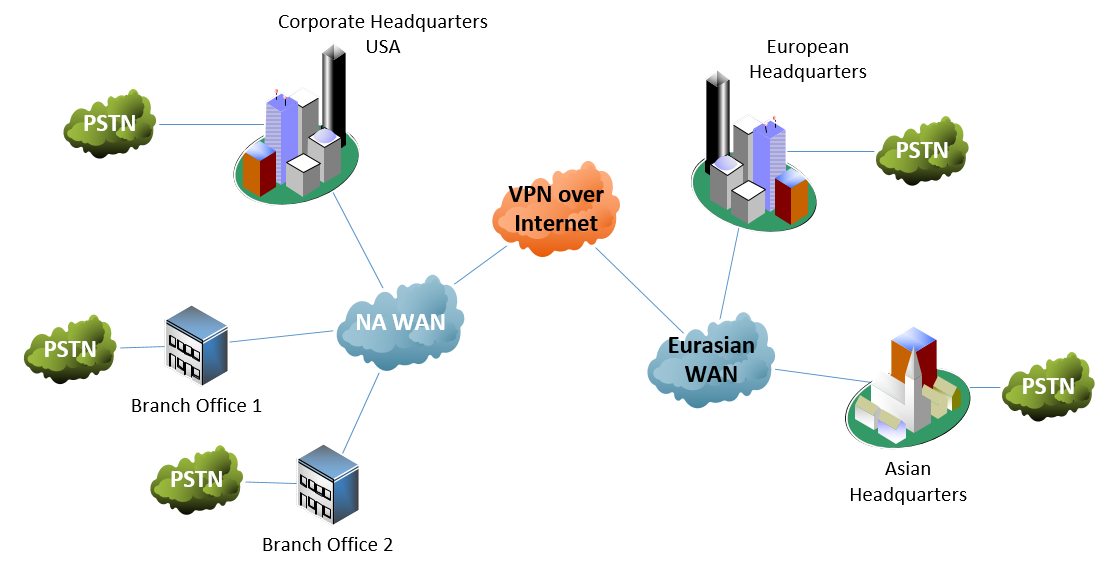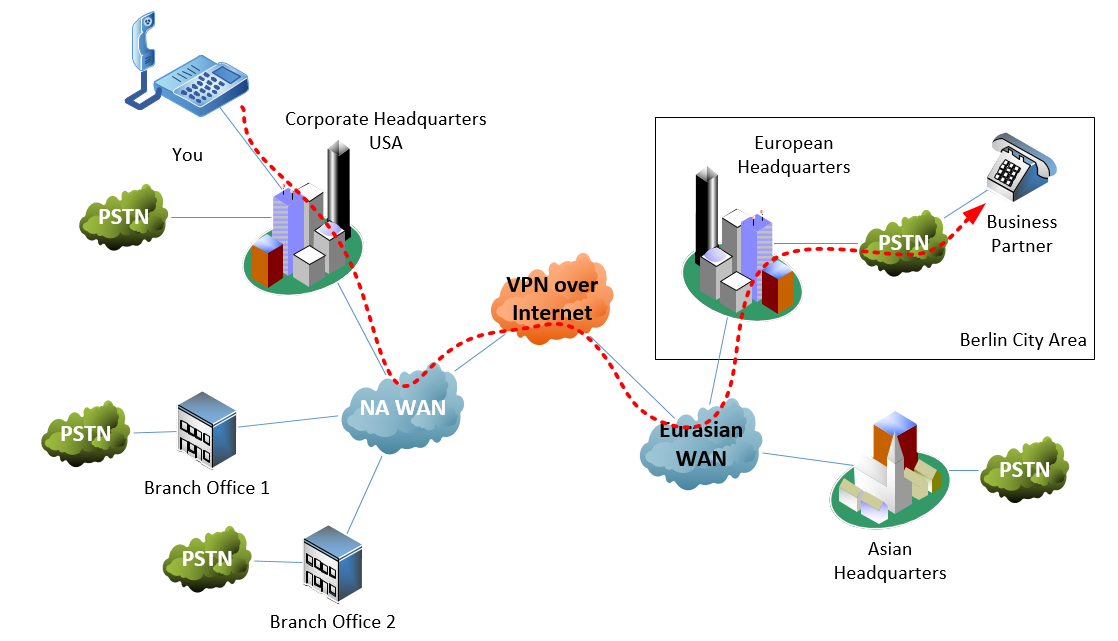Implementing telephony solutions in an enterprise environment can be daunting. The level of difficulty and complexity usually escalates with the number of end users. Implementing a telephony solution in a multisite environment takes the complexity to a different level altogether.
In this article we offer up some tips for streamlining the implementation of a multisite VoIP deployment so the company can derive the maximum benefit from the solution.
VoIP to the rescue
Using VoIP technologies, we can interconnect corporate and branch offices via a private network so that all communication between sites is routed over a WAN, rather than the PSTN. Enterprises typically already have WAN deployments for their data networks; it’s just a matter of leveraging them for VoIP.
The below diagram is an example of one of many possible multisite VoIP deployments for a multinational corporation.

Key considerations
When implementing a multisite VoIP system, there are some issues that are generally not a concern for single-site deployments. These include:
- Overlapping dialing plan
- Techniques for the reduction of PSTN charges such as Tail End Hop Off (TEHO)
These must be dealt with in an appropriate manner in order to leverage the multisite VoIP environment as optimally as possible, and are described in further detail below.
Dialing plan options and issues
The dialing plan is important because it must provide a unique directory number to each internal user. While this is usually not an issue in a single-site deployment, it can be a concern when multiple sites are involved. Telephony administrators typically have to deal with an overlapping dial plan when longstanding independent installations that each have their own dialing plan are being interconnected for short-code internal dialing. This is common with company takeovers when new sites are added to the network.
Depending on how numbering is implemented at each site, some internal number ranges may overlap with those in other remote sites. Whether or not overlapping occurs, and how to deal with it when it does, depends on the way in which the dialing plan has been implemented at each site. There are various ways to deal with this and some important caveats to each.
Internal extensions – One method of implementing a dial plan is to have a single number for incoming calls for the whole enterprise. Anyone who calls this number will be prompted by an auto attendant to input the extension number of the intended destination of the call. In such an implementation, the called number from the PSTN has no correlation with the extension number. For calls that occur internally, there are very few restrictions on the extension numbers that can be used.
Direct inward dial extensions – Some corporations prefer to eliminate the auto attendant from the above process. This is achieved using a feature called direct inward dial, or DID. In such an implementation, a telephony provider will deliver a block of numbers to a corporation, such as 480-555-1100 to 480-555-1499, and allow the enterprise’s internal telephony network to route each of those numbers directly to an internal extension. In such cases, it is industry best practice to match the internal extensions with the last few digits of the external PSTN number. So, a company may have several hundred phones with internal extension numbers, each of which corresponds to the full PSTN number of 480-555-1YYY where YYY is the internal extension.
Hybrid system – There are some situations where you would prefer to have some DID numbers for some users and independent internal extensions for others. This is also an acceptable, albeit more complex, solution.
Limitations due to special codes and prefixes – Codes such as dialing 9 to obtain an outside line or dialing 0 to connect with the receptionist are also an issue. The use of such codes eliminates the use of whole blocks of extension numbers starting with 9 or 0. For DID implementations, this could conflict with three-digit extensions that may result from a PSTN number of the form 480-555-19XX.
Implementing the dial plan in a multisite environment
Internal extension numbers
The easiest dial plan to implement for a multisite environment is that of the internal extensions. Because these numbers are independent of any external PSTN numbers, they can be adjusted, changed, mixed and matched to your heart’s content. For example, if you have three sites, you can set your internal extensions so that all 3XX numbers belong to site one, 4XX to site two and 5XX to site three. This makes your plan more intuitive for the end users.
There are downsides to this solution, however. The first is that with internal extension numbers, the caller ID that external parties see when an employee is making an outbound call through the PSTN is that of the central number and does not include the extension number information, so the called party doesn’t know the identity of the caller. Secondly, some corporations do not like to have an auto attendant asking for an additional extension number, and would prefer the DID solution.
DID
The DID solution, although cleaner, is more difficult to implement in a multisite environment. Remote sites, especially those in different area codes, will likely have DID numbers whose final three, four or five digits overlap.
Let’s say at one site, you have DID numbers of the form 480-555-25XX and in another site you have DID numbers of 416-555-75XX. You want to interconnect these sites with three-digit dialing. However, since both sites have the internal extension ranges of 5XX, some of the extensions used at one site could be identical to extensions at the other site, making a dialing plan with unique numbers impossible to deploy. The following diagram depicts this predicament.

For such cases, you can use one of two workarounds.
The first involves the use of a site code. In the above diagram, Branch Office 1 has an extension number of 525 and so does Branch Office 2. You can keep both of these numbers as they are, and just add a site prefix code such that when Branch Office 1 calls Branch Office 2, users are instructed to precede the call with a prefix of 8 (or whichever number is chosen as the prefix for that site). So, to reach extension 525 at Branch Office 2, a caller in Branch Office 1 would dial 8525. All calls within a single Branch Office would just use three-digit dialing.

Keep in mind that by adding site prefixes, additional numbering constraints are being applied, because internal extension numbers at each site cannot begin with the same digit as any configured prefixes. In this example, with the implementation of the 8 prefix, no internal extension numbers in the form of 8XX can be used. If you require multiple site prefixes, two-digit prefixes are also an option. As you can see, although this is a viable solution, it is not a very scalable one.
The second solution involves the use of longer short codes. Instead of using a three-digit dialing system, use a four-digit system that will make each internal number unique. If this is not possible because the fourth-to-last digit is the same at both sites, then even a five-digit system is preferable if it makes the dialing plan simpler and more intuitive.
Tips for multisite and hybrid solutions
When multiple sites are involved in different area codes or countries, the normalization of a dialing plan among these sites can quickly become unmanageable. While it is much easier to implement this setup from scratch, the reality is that most multisite deployments are a result of interconnecting existing networks. Here are a few suggestions for streamlining the process.
- Consolidate all of the current dial plans at each location to be interconnected, and identify the prevailing methodology. Determine if that methodology is the best one to be applied to the whole multisite deployment or if another one should be proposed.
- Examine the possibility of changing the smaller sites to the same methodology as the larger sites.
- Consider where prefixes, extensions with more digits, or changing extension numbers could alleviate some of the difficulties in normalizing the dial plan.
- For best results, minimize the changes as much as possible.
- Determine whether it is more useful to consolidate PSTN connectivity within one or a few sites, or to have each site connect to the PSTN individually. We’ll discuss this further in a subsequent article.
- Don’t be afraid to suggest a complete overhaul of the dial plans in some smaller sites to make the total dial plan more intuitive and scalable. It will be worth it in the long run.
- Present the available options to company leadership and have them make the final decision on how to structure the dial plan.
The human element
So far, all of this has to do with the practical and technical side of things. The human element also needs considering. Employees can become attached to their extension numbers and may resist having them changed. More importantly, some numbers are made known to third parties such as customers and partners, so changing them can cause some havoc. For some implementations, the human factor may be the most difficult part of the dial plan normalization process. For this reason, it is a good idea to have the administration deal with the human factor as much as possible while you deal with the technical issues that you have been hired to perform.
Cost savings through Tail End Hop Off (TEHO)
Tail End Hop Off or TEHO is a technique where long-distance and international toll charges can be avoided when calling a number within a city where one of your remote locations exists. A properly configured multisite VoIP system can route the call to exit the system at the PSTN connection closest to the called party’s location, thus minimizing or even eliminating toll charges.

The diagram above portrays a call made to a business partner located in Berlin, where your company has an office. Your VoIP telephony system is already configured to know that a connection to the PSTN exists in the destination area code. The IP PBX manipulates the entered telephone number, routes the call through the WAN, has the call exit the system at the PSTN connection in Berlin, and terminates it at your partner’s telephone. This bypasses long distance and international toll charges and charges you only the portion of the call that is actually routed by a telco, specifically, from the PSTN connection in Berlin to your partner’s landline. From the telco’s point of view, this is a local call, so only local call charges (if any apply) would be charged.
If your multisite implementation crosses state, national or international boundaries, TEHO will be useful to your business. Nevertheless, the following issues must be kept in mind.
- Unlike in the USA and Germany, TEHO may be illegal in some countries. Make sure you verify the legality of such a configuration before going ahead with it.
- There are some issues with caller ID in such a call. In the above example, your partner in Germany will see an unknown Berlin number as the caller ID.
- When you call 911, emergency services use caller IDs in order to determine your location. If your system is not correctly configured and a call to 911 is routed through TEHO to another branch in another state, for example, emergency services will be dispatched to the incorrect address.
Conclusion
Despite the challenges inherent in implementing a multisite telephony system, its benefits can be immense. Primary advantages include a reduction in telco toll charges for long distance and international calls that are routed over a WAN, as well as the simplification of the corporate directory through short-code communication between the sites.
You may also like:
The 3 most common hybrid deployments for VoIP-to-analog solutions
SD-WAN is good for single-site companies, too
A simple process for transitioning to VoIP










Comments